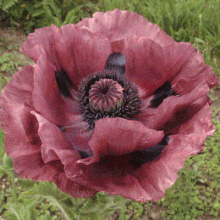Papaver orientale 'Patty's Plum'
| Papaver orientale 'Patty's Plum' | |
|---|---|
 | |
| Genus | Papaver |
| Species | Papaver orientale |
| Cultivar | 'Patty's Plum' |
| Breeder | Patricia Marrow |
| Origin | Somerset, United Kingdom |
Papaver orientale 'Patty's Plum' is a poppy originally discovered growing in a compost heap at Kingsdon Nursery Garden, Somerset, UK, by Sandra Pope of Hadspen House, Somerset, UK, who had come to work in Mrs Patricia Marrow's garden.[1] After the damson colour of the poppy was noticed, Marrow propagated it. She and Pope later came up with a name "Patty's Plum" because that is Marrow's first name, and it is typical of Marrow to describe the colour as "Plum".[2] The cultivar has also been known under the synonym: Papaver orientale 'Mrs Marrow's Plum'.[3]
Description
Papaver orientale 'Patty's Plum' is an herbaceous perennial.[3] This cultivar grows to a maximum height of 80cm tall.[4] Plants host large flamboyant flowers, which possess black blotches at the base of each petal.[5] Blooms are purple[6] or plum pink in colour and will fade with age.[3]
Uses
Papaver orientale 'Patty's Plum' is used as an ornamental plant, which can be planted into flowerbeds and garden borders.[3] Due to the cultivars large flowers and unusual colour it is also sometimes used as a cut flower.[7]
References
- ^ Bourne, Val (6 June 2008). "Papaver orientale 'Karine': How to grow".
- ^ Ratgirl, Paghat. "'Patty's Plum' Perennial Poppy".
- ^ a b c d "Papaver (Oriental Group) 'Patty's Plum'". Royal Horticultural Society. 2022-06-02. Retrieved 2022-06-02.
- ^ Anderton, Stephen (2021-05-22). "How to grow the perfect poppies in your garden — an expert guide". The Times. Retrieved 2022-06-13.
- ^ "Papaver orientale 'Patty's Plum'". www.gardenersworld.com. 2022-06-02. Retrieved 2022-06-02.
- ^ "Papaver orientale L." powo.science.kew.org. 2022-06-13. Retrieved 2022-06-13.
- ^ Thompson, Cathy (2021-04-28). "Gardening in France: Oriental poppies go centre stage in springtime". The Connexion. Retrieved 2022-06-13.
